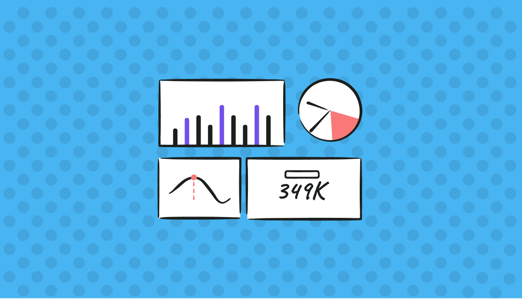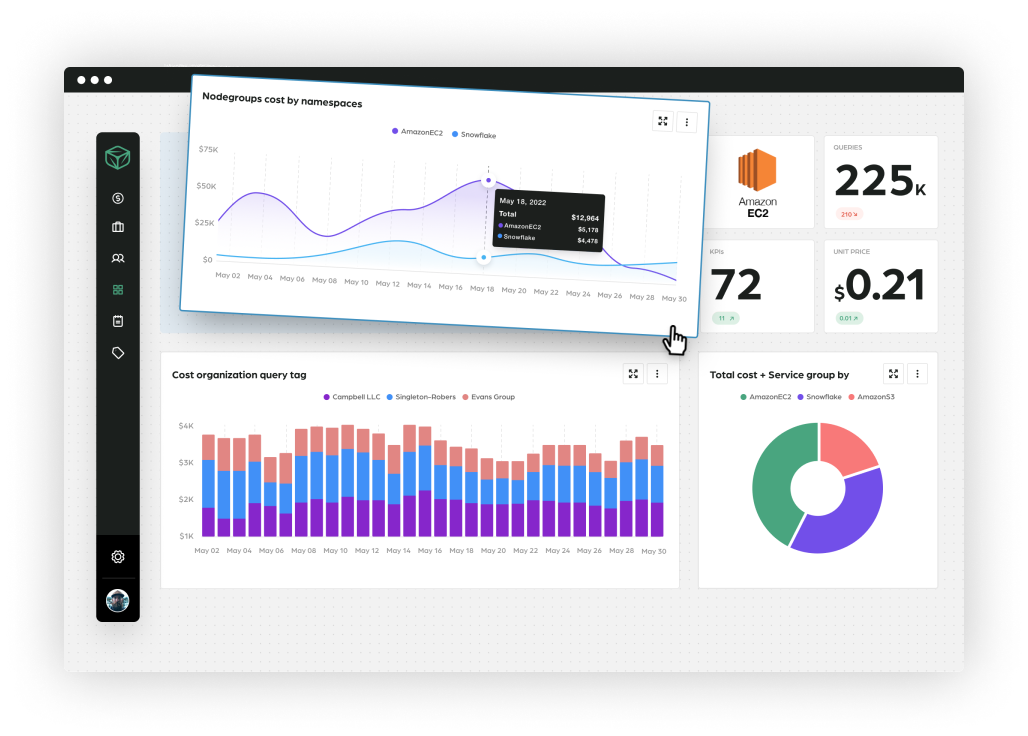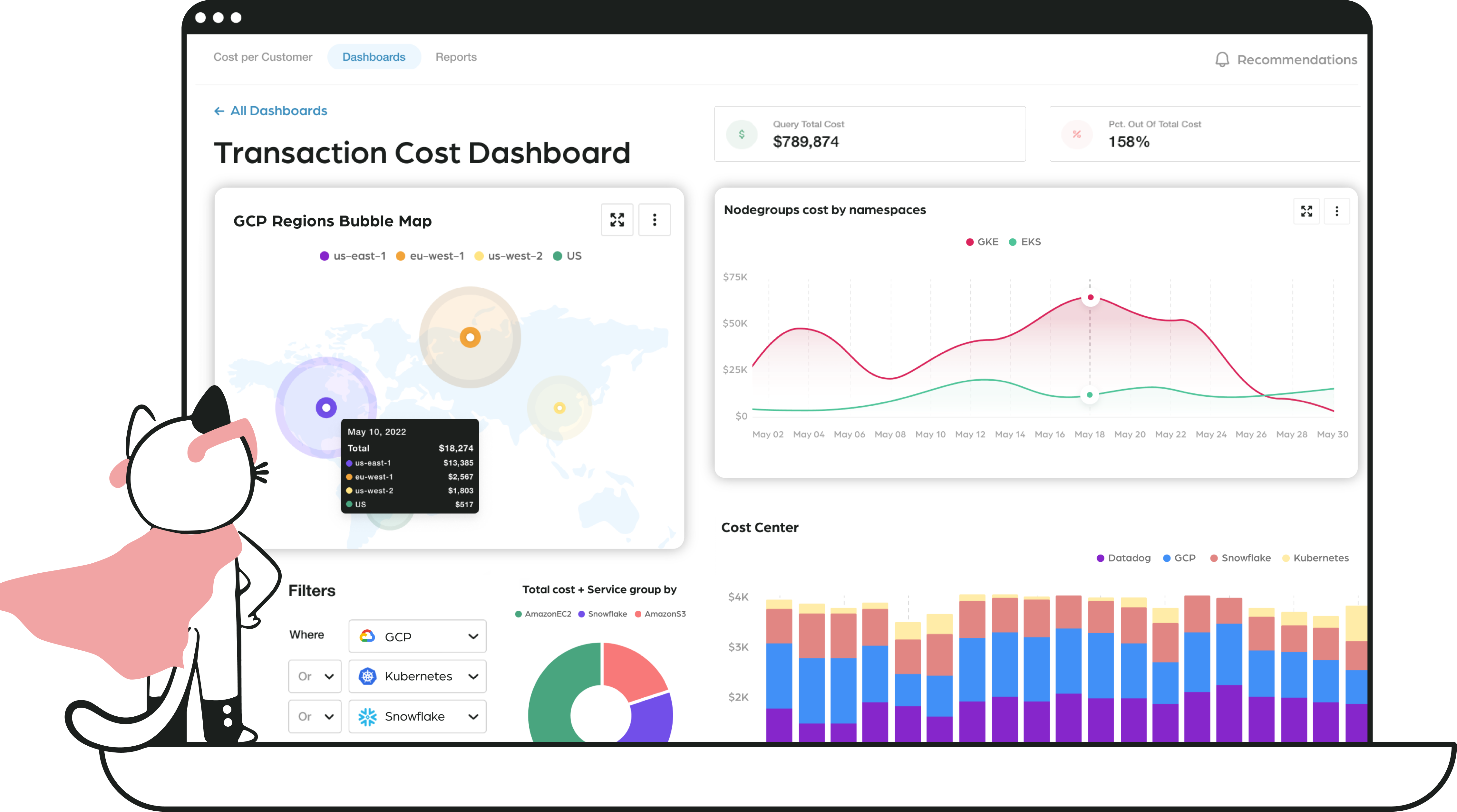
Cloud billing is complex. Every cloud provider offers hundreds of services with various instance types and specifications. Because resources in the cloud autoscale based on usage patterns and can run for an hour, minutes, or seconds, billing is unpredictable. Furthermore, the various cloud providers talk in different languages. All of this means monitoring, managing, and optimizing the variable expenses of cloud resources is essential for enterprises today.
The complexity of the cloud service goes beyond the challenge of responding to variable costs according to usage patterns. Pricing models include spot instances, savings plans, on-demand, and reserved instances. There are further pricing strategies like pay as you go, pay less upon additional usage, and save more when you reserve. This is why deciphering the details in a cloud bill requires the intimate examination of thousands of lines of cloud spend details based on the services used, regions, and pricing models.
Having granular visibility into cloud costs and resource usage can help you make better decisions for your business. To drive a FinOps culture within your enterprise, it is vital to empower development teams with visibility over their cloud spending and the ability to forecast these costs. With full visibility over cloud spend, FinOps teams can provide guidance and visibility into cloud usage and optimize spending by purchasing and managing reserved instances for cloud usage across all accounts.
In this article, you’ll learn about the complexity of cloud billing, how to get in-depth visibility over your cloud spend, and how to handle costs efficiently in multi-cloud environments.
Visibility Over Cloud Spending
In the last decade, the cloud service providers have made significant improvement to their spending monitoring services. AWS’ billing file, for example, has gone through a remarkable journey with several iterations to include invoices, cost allocation reports, detailed billing reports with resources and tags, and cost and usage reports. The AWS Cost and Usage Reports (CUR) file is a comprehensive report in JSON format that allows programmatic ingestion for in-depth cost analysis. AWS CUR also helps monitor and manage the usage of reserved instances. These billing reports are periodically stored in an S3 bucket and configurable per various intervals, like hourly, daily, and monthly.
The complexity associated with billing data isn’t going away, so using a cloud cost management platform is vital for reporting and gaining insights to drive cost optimization decisions in your organization. To assist you in this, Cloud Cost Management tools like Finout integrate with the AWS CUR file and other APIs to give you complete accuracy of your cloud spend.
 Cost Benefits of Understanding Billing Data
Cost Benefits of Understanding Billing Data
Having granular insight into your cost reports helps you to identify trends and detect anomalies. At a high level, your billing data includes the billing period; total cost; and the total number of active services, active accounts, and active regions. You should also be able to dive deeper into the cost and usage data to identify cost drivers based on services, accounts, regions, instance types, resources, and tags.
Billing data will also reveal the reserved instance utilization across your accounts and cost optimization often means identifying opportunities to increase the reserved instance usage.
Generally, cloud bills are categorized based on services and regions. An invoice contains the cost summary for the billing period, charges, and savings, including any savings plan discounts and enterprise program discounts, charges by service, and charges by account. So in a multi-account environment, it’s beneficial to be aware of certain trends, like the top-five most expensive service accounts – to focus on cost optimization measures.
Controlling Cloud Spend
Controlling your cloud spend is not easy. As you migrate workloads from on-premises to a cloud environment, you move from a CapEx model to an OpEx model (capital expenses to operational expenses). In the former, you had strict control over the budget, and any new infrastructure cost had to be approved with a long-term vision. However, things started changing with cloud adoption, where teams can freely spin up short-term resources to meet their business requirements; generally termed as operating expenses.
When running your workloads at cloud scale, it’s easy to over-provision your services to meet performance SLAs specified by the business. This creates a lot of additional expenses as well as wasted resources. So, you need tools that provide observability and analytics to effectively manage your resources in the cloud.
Most of the time, when you get a bill that is beyond your expectations, you need to start focusing on the underutilized and over-provisioned resources in your accounts. The cloud bills should be accessible to both your finance department and development teams. This will ensure everyone has insight into actual cloud spend and can associate costs directly with your business products.
Having access to resource utilization metrics is key to rightsizing cloud resources, as these will allow you to track over-provisioned resources. Setting up a proper budget is also critical to help control your cloud costs.
Managing the Complexity of Multi-Cloud Environments
Multi-cloud implementations provide much flexibility in terms of choosing the best tools and services from your cloud providers. They also reduce the risk of vendor lock-in. However, they can result in complex cost and resource management overhead due to using services from a combination of private and public cloud providers like AWS, Azure, and GCP. In addition, it is difficult to manage spending since every cloud provider has its own billing tools and patterns.
To avoid ending up with increased infrastructure costs because of unused or unoptimized resources, it’s essential to have a good understanding of the scalability configurations and billing mechanisms across cloud services providers. This means that a single view from which to observe your cloud cost across environments is a must-have. The alternative is expecting the Finance department to invest significant time in a forensic investigation every time that DevOps wants to understand their cost centers or investing development time in developing bespoke tooling.
Need for Centralized Cost Dashboards and Analytics
An organization can have many business domains, and making them accountable for their cloud resources is in the company's best interest. IT showback and chargeback provides visibility into a business unit’s costs and helps maximize the value of their cloud spending. Showback can be the first step, where there is cost transparency within departments and employees are aware of cost/usage. The ability to correlate cloud spending to the respective business unit is essential. Chargeback is a step further, making departments pay for cloud usage. It is an enforcing mechanism to drive a culture of accountability within the organization.
The consolidation of multiple cloud bills and a centralized dashboard for cost reporting across business domains is challenging. Enterprises need to forecast their cloud spending, create a cloud budget, and optimize their current costs by purchasing reserved instances. Understanding cloud bills is tricky; you need proper tools to provide cost visibility and stay informed about anomalies and rightsizing opportunities.

The Future is Better-Informed
Cloud cost observability platforms put you back in control. Since billing data is time-based, you can use anomaly detection to monitor and send alerts when unusual spending is detected. If you receive multiple cloud bills at the end of the month, it can be challenging to have an overall view of your spending given the various prices and separate tools required for cost analysis. With Finout, you get a unified cost management platform that provides a unified bill. This unified bill combines all of your AWS, GCP, Datadog, Kubernetes, and Snowflake invoices into a single megabill, consolidating the view of your cloud spend. In addition, you can customize the costs you see, for example, per development team, business unit, or certain features.
Contact Finout today to learn how you can quickly embrace the FinOps model and take control of your cloud spend.








